I'm working on a game where I create a random map of provinces (a la Risk or Diplomacy). To create that map, I'm first generating a series of semi-random points, then figuring the Delaunay triangulations of those points.
With that done, I am now looking to create a Voronoi diagram of the points to serve as a starting point for the province borders. My data at this point (no pun intended) consists of the original series of points and a collection of the Delaunay triangles.
I've seen a number of ways to do this on the web, but most of them are tied up with how the Delaunay was derived. I'd love to find something that doesn't need to be integrated to the Delaunay, but can work based off the data alone. Failing that, I'm looking for something comprehensible to a relative geometry newbie, as opposed to optimal speed. Thanks!

